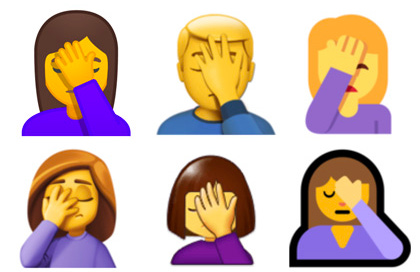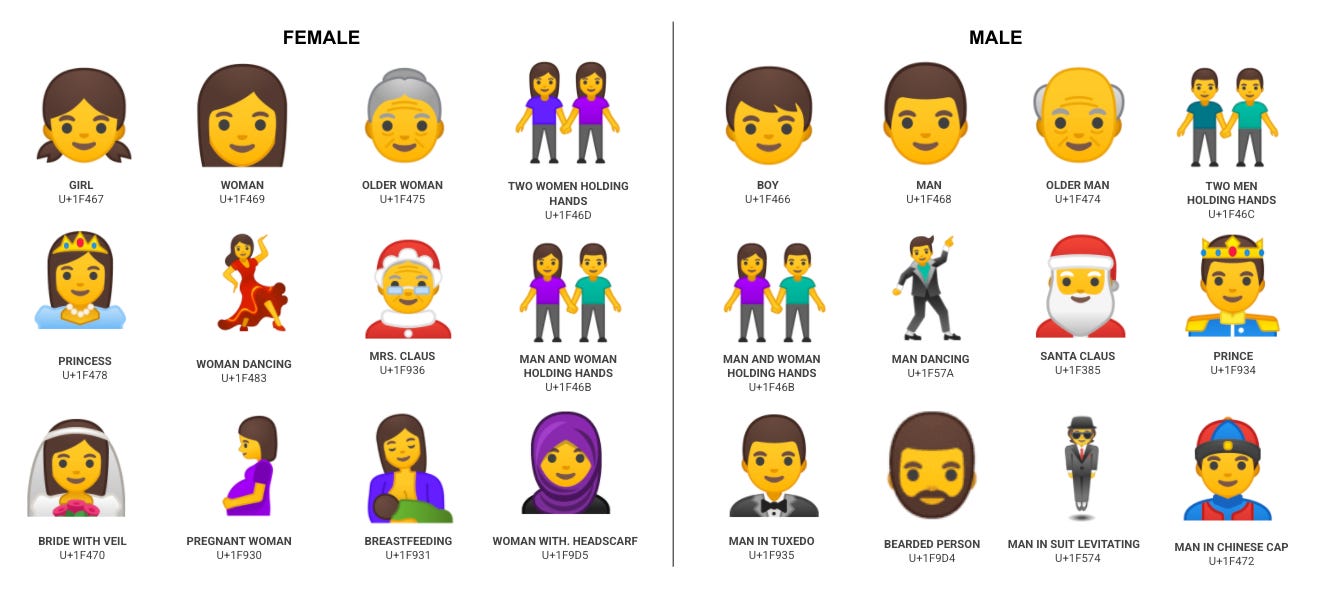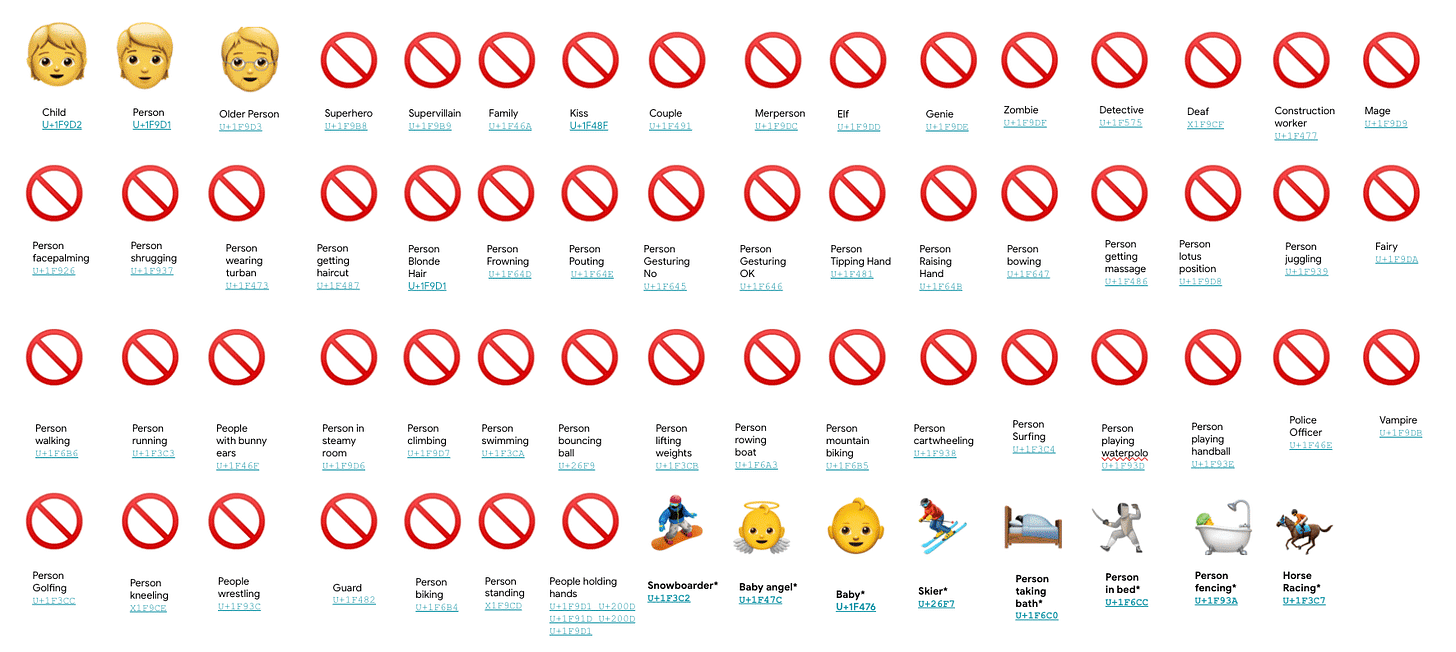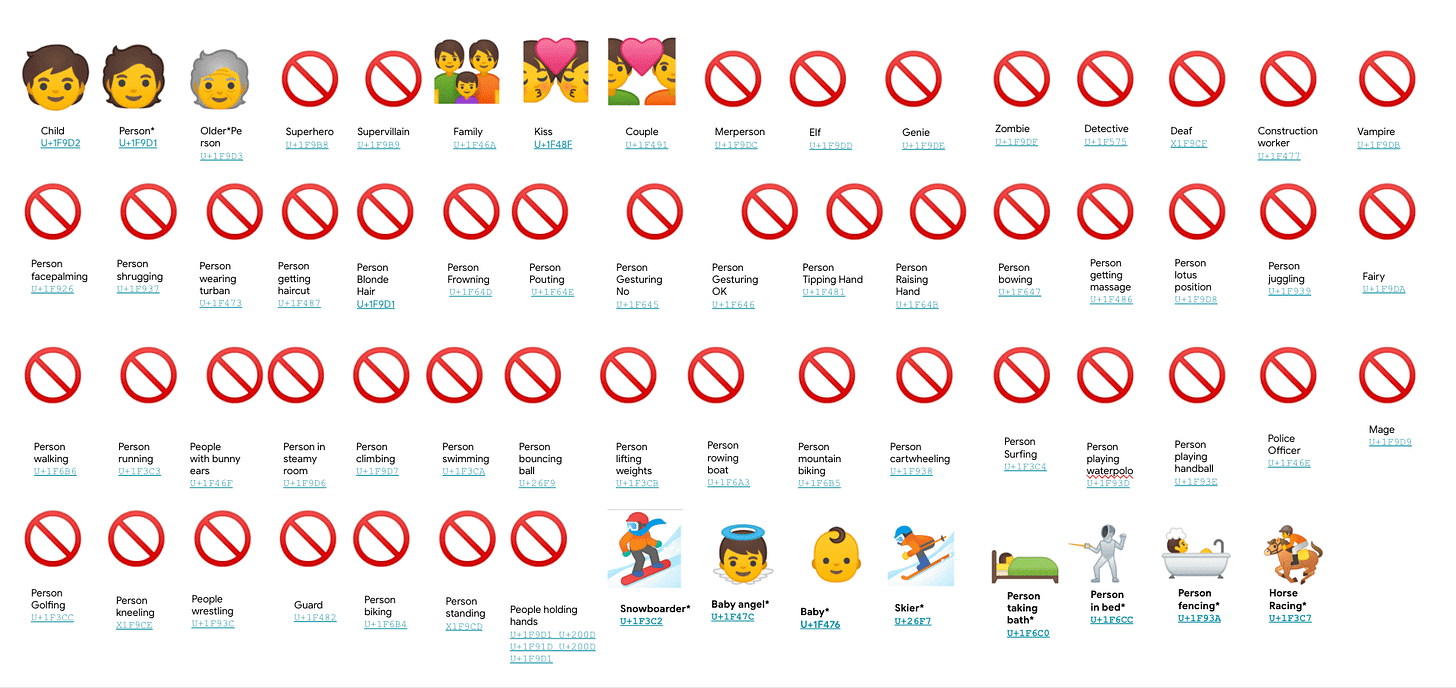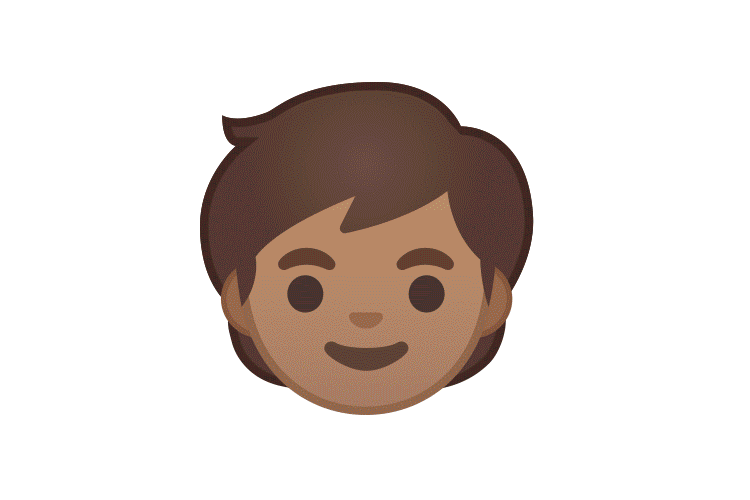When a Merperson is a Merman🧜
How a text to a friend during a forgettable meeting resulted in an unforgettable change in your emoji keyboard
In 2018 I messaged a colleague, “Love a good mansplain (woman facepalm emoji)” from my Pixel phone. She received, “Love a good mansplain (man facepalm emoji)” on her iPhone.
What…in the world….. is going on here? 🧐
Every letter you are reading on this screen is assigned a code point. The Letter A? It’s code point U+0041. When you send “A” to someone else there is a reasonable expectation that they will also see the letter “A”. (The letter א? Code point U+05D0. The letter ß? Code point U+00df, etc.) This operates the same for emoji: both of those people facepalming 🤦 map to the same code point (U+1f926) and yet something felt broken (See Fig. 1).
Upon further investigation it turned out these inconsistencies were happening a number of times 😱. 72% of people emoji are supposed to have gender inclusive representations but only 13% presented in an ambiguous manner. You send a mermaid, they get a merman. They send you a superwoman, you get a superman (See Fig. 3).
SMH. WHO WANTS TO BE MISUNDERSTOOD????
The problem wasn’t limited to suboptimal interoperability. An audit of all the people emoji made it clear that even when some seemed to be working aka there was “design alignment” the presentations frequently reinforced very tiresome stereotypes. For example, many of the “professional” emoji that were not explicitly gendered (aka Police Officer, Construction Worker, Engineer, etc.) defaulted to MALE.

It gets worse. Many of the gesture based emoji (which tend to be emotional like pouting, frowning or shrugging) defaulted to WOMEN. And this was after a big bruhaha to bring more female representation to emoji. 😮💨 Baby steps I guess. Before 2016, the only professional emoji for women were fairly limited — just a bride and a princess — which are not actually career options.

TL;DR
Men got to be the default professional emoji and women got to be the default emotional emoji. This is deeply annoying and stupid. Something had to be done.
How did we get here? Where even are we?
At the time of this text exchange I had recently joined Unicode’s Emoji Subcommittee. As we evaluated if “butter” or “yo-yo” and “bucket” were valuable additions to our keyboards I was left wondering, “How can we add new emoji when the current set aren’t working as intended?” During one of the quarterly Unicode Technical Committee meetings I came across Charolette Buff’s exhaustive documentation. Then, someone pointed me to Paul Hunt’s recommendation and numerous documents from the Emoji Subcommittee.
The Unicode Standard's specifications were pretty clear, “Other than the above list, human-form emoji should normally be depicted in a gender-neutral way unless gender appearance is explicitly specified,” stated document TR-51 (think of it as an emoji bible). And yet, only 11 emoji had universal gender ambiguous designs: (See Fig. 6) (1) Child 🧒 (2) Adult 🧑 (3) Older Person 🧓 (4) Snowboarder 🏂 (5) Angel 👼 (6) Baby 👶 (7) Skier ⛷️ (8) Person in bed 🛌 (9) Fencer 🤺(10) Person in Bathtub 🛀 (11) Horse racer 🏇.
The experience finding and using emoji was suffering as a result. Apple’s default keyboard displayed two genders using twice the amount of real estate necessary to scroll through and forcing users to choose between an artificial binary. Google’s default keyboard displayed the gender inclusive code point as the default but because there were no gender inclusive designs you saw an arbitrary mix of “male” and “female”.
To deliver on a better experience overall we broke it down into three phases. The proposal was straightforward.
Be faithful to the Unicode Standard’s guidelines
Create an emoji experience is more intuitive to navigate
Simultaneously push inclusivity as a priority in pursuit of those goals
Phase 1 🎉
Redesign existing code points where gender is unspecified. These rolled out in 2019 as part of the Emoji 12.0 release
Phase 2 🎉🎉
Modify the Unicode Standard’s guidelines around which emoji are explicitly gendered. In the past year, many of were removed from the list and now the defaults subscribe to a more inclusive presentation. (Seven remain explicitly gendered).

Phase 3 🎉🎉🎉
Propose new emoji to fill in the gaps. As new emoji are added we made it very clear that gender inclusive emoji are not exclusively non-binary and should never be assigned a sex sign as part of their encoding. By keeping them “tabula rasa” they can be used to build other emoji (Ex. Cartwheeling woman (🤸♀️) is a ZWJ combination of “[gender inclusive] person cartwheeling” and “♀”. )
Wait, Jennifer. Wait wait wait. The “gender inclusive emoji” are not “non-binary”? What are they then????
Think of it this way: “gender-inclusive” emoji are intended to be unmarked or ambiguous and represent a spectrum of gender presentation — not exclusively or explicitly represent only people with non-binary gender identity or presentation. This is tricky since there is no one way in which a non-binary individual (or person of any gender) can or should present so we try not to suggest otherwise. Sometimes a Doctor is just a Doctor.
I talk about some of the design challenges and technical considerations in this video which was just uploaded to youtube this week ^_^:
Where are we now? Where are we going?
Ongoing discussions and questions remain, “Why not just encode smileys and stop encoding people emoji?” 😇 “What happens if we only encode gender inclusive designs moving forward?” 🤠 “What do we gain by including man/woman designs?” 🤡 “Do they have to be called man/woman?” 😎 I know, I’m a lot of fun at parties. 🤓
Since 2019 (when this talk was recorded) platforms have been more proactive to ensure better interoperability. Gender inclusive designs rolled out for most and now I can confidently text my friend without fear of random men popping up in our text messages 😉. “THEY” became word of the year. A proposal was written to add 23 more gender inclusive emoji. The experience using emoji has benefited — Android’s gboard updated and now that random mishmash (See Fig. 7) is clear and consistent. (However, the iOS keyboard layout is a bit of a head-scratch — each person emoji appears in triplicate making it hard to quickly scan what you are looking for.) Nonetheless, as keyboards and designers make gender inclusive the default a remarkable thing is happening: emoji are moving away from “heterosexuals are the default" to “here are some people, here is a family.” ❤️
— jennifer 😘
This week we looked at some of the technical considerations when executing on the Unicode Standard’s guidelines as it relates to gender. Next week will focus on some of the design challenges. Until then, some further reading:
L2/15-048 Adding gender counterparts to emoji list
L2/16-160 Expanding Emoji Professions: Reducing Gender Inequality
L2/17-232 Proposal for Fully Gender-Inclusive Emoji
L2/17-195 Add Emoji Gender Properties
L2/17-071 Gender-Neutral Human-form Emoji
L2/18-022 Gender Emoji Strategy
L2/19-078 Using Gender Inclusive Designs For existing code points
L2/19-189R Proposal for Consistent Gender Options for Emoji ZWJ Sequences
L2/19-231 Recommendations for Gendered Emoji ZWJ Sequence

